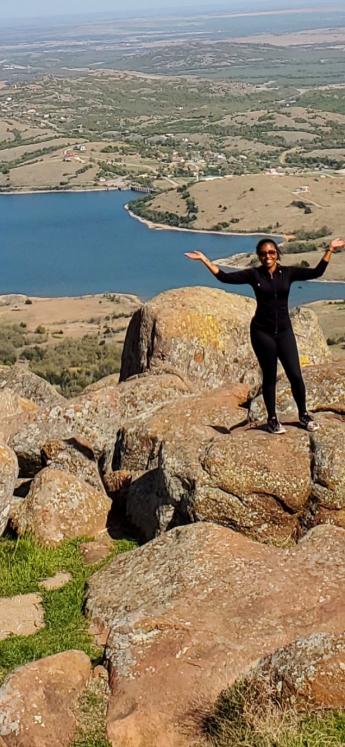
Once you get here, you might not leave, says GSA intern
Post filed in: Jobs and the Economy
LaKeya Hayden was in graduate school at Bowie State University, teaching fourth graders spelling and grammar, when a classmate told her about internships at GSA.
“Back then, I had no idea what GSA did,” she said. “I thought, ‘Let me give it a shot because I know I can always go back to teaching.’”
She enjoyed her interview, she said, and liked the questions she was asked and information given about GSA. And, she appreciated GSA’s flexibility to let her finish her master’s degree in human resource development while interning.
Hayden interned with the Office of Organizational Resources, the office that managed GSA’s interns in 2012. She spent her days helping to build the program, and said she was hooked. The feeling was mutual, and Hayden was brought on full time.

She has been with the agency for the past decade and now works in the Public Buildings Service’s Office of Mission Support and Mission Improvement.
She enjoys her work as a program analyst where she leads several PBS programs, such as the mentoring program in the national capital region and connecting PBS employees with top leadership one-on-ones.
“We try to keep up the morale by getting the employees what they need, making them feel valued at GSA, and that their voices are being heard,” she said.
GSA ranks fourth among federal agencies of similar size in employees’ satisfaction with their pay, performance management, and customer experience and equity.
Hayden’s path to a government career is not uncommon. According to GSA Pathways Program Officer, Elise Wiederholt, GSA hires approximately 200 Pathways participants every year.
Like Hayden, Wiederholt started her government career through an internship.
There are 213 interns serving in GSA’s Pathways Program, the federal government’s hiring path for current students and recent graduates. The Pathways Program includes the Presidential Management Fellows program for recent graduates of qualifying advanced degrees.
This year, GSA welcomed 10 Presidential Management Fellows, the most PMFs the agency has had, GSA Deputy Administrator Katy Kale tweeted yesterday.
These internships and federal employment are not just for those living near the nation’s capital: About 85% of federal employees work outside of Washington. All interns and fellows in the Pathways Program are paid, and if they successfully complete the program, they may be eligible for a permanent job, according to OPM.
“GSA Pathways program participants are exposed to distinctive functions across the agency,” Wiederholt said. “Many of our programs offer rotations within business lines to harness additional skills and make professional connections.”
Another bonus is that GSA, like many federal agencies, offers student loan repayment programs to eligible applicants.
Attracting college students and entry-level employees to federal service has become imperative: One third of the federal government’s 2.2 million federal employees are 55 and older, and in less than two years, the youngest members of that group will hit the government’s minimum requirement age, potentially leaving a huge gap in the federal workforce.
This, in part, is why GSA is partnering with the Office of Personnel Management, the federal government human resources agency, to recruit and retain early career talent.
“I’ll just put that out there right now, I’m in my 50s,” said Kiran Ahuja, Director of OPM during the latest episode of GSA’s podcast, “GSA Does That!?”
“We’ve tried to set the tone across the federal government that we need to prioritize early career talent and hiring and recruiting those individuals,” Ahuja said.
Balancing the aging workforce isn’t the only data point that GSA and OPM are hoping to tackle.
Attracting the best talent and making government jobs accessible to all is key, Ahuja discussed with GSA Administrator Robin Carnahan during the podcast.
Carnahan said studies show that the more diverse a business is, whether it’s commercial or government, the stronger the results.
“It’s about intentionality and understanding that we’re stronger when we have a diverse workforce, and just be thoughtful about how we’re going to both go out and recruit, but also retain a diverse workforce and talent,” Carnahan said.
The federal government is working to make its application and interviewing process faster to compete with private industry. And OPM created a website where all internship openings across the federal government can be found in one place: intern.usajobs.gov.
Additionally, OPM and federal agencies are looking at better uses of bulk hiring, or using a candidate’s application toward several vacancies, Ahuja and Carnahan said.
Regarding salaries, Ahuja said there are some pay flexibilities to help recruit and retain employees in specific locations and localities, such as special rates for a biomedical engineer in the middle of the California desert or a nurse practitioner in a small town.
One factor that draws many people to government service is the sense of duty, Ahuja said, and it’s strong among younger adults and those looking to launch a career.
“We win on mission every single time,” she added.
For someone like Hayden, who turned her internship into a career, she encourages all considering a government career to give it a try.
“It just might work out better than you imagined.”

 U.S. General Services Administration
U.S. General Services Administration
